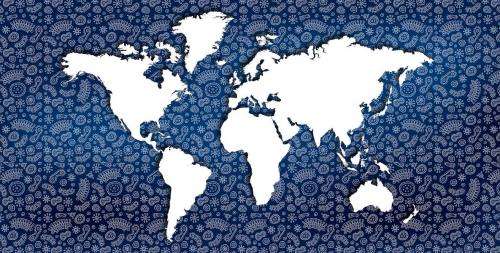Study suggests same microbes may be present in oceans worldwide

(Phys.org) —A new study from researchers at the U.S. Department of Energy's (DOE) Argonne National Laboratory could herald a sea change in how we think about microbes in the ocean.
In a paper published last month in the Proceedings of the National Academy of Sciences, Argonne microbiologist Jack Gilbert and colleagues found that as many as two-thirds of the bacterial species found in the English Channel could also be found in other marine environments around the world, from tropical mangrove forests to deep-sea vents.
The study is part of an ongoing effort to catalogue microbes around the world, called the Earth Microbiome Project. Scientists scoop up a sample of seawater or dirt and sequence the DNA of the species within. Sequencing it more thoroughly, as Gilbert and colleagues did this time, catches the rarer microbes – which might be just one or two cells in a liter of seawater.
Scientists have been aware for centuries that different microbes flourish in different conditions. Some like it hot and acidic, others alkaline, while others like a lot of phosphorus or iron in the water. Different species rise and fall when conditions change.
"Conventional theory said that these bacteria have to migrate to where their favorite resources are," Gilbert said. "But what this paper suggests is that the old theory of bacteria moving into an environment is wrong. All of the species are always there, just in very small amounts."
If conditions change to suit them, those microbes quickly jump on the advantage and multiply.
The team called this concept the "microbial seed bank."
Under this theory, it's possible that nearly all microbes are present virtually everywhere in the ocean – some thriving, some grimly hanging on. Bacteria can go into stasis, a type of hibernation, and drift along waiting for their moment.
One of the reasons this is important is because microbes play an integral role in climate change. They are the first level of the food chain; they are also directly responsible for much of the massive worldwide cycling of elements like carbon dioxide and oxygen.
"The majority of the oxygen in the air comes from microbes in the oceans," Gilbert said. "If we want to understand how climate change will unfold, we need to look at the contents of the oceans."
Elsewhere at Argonne, groups led by computational climate scientist Rob Jacob are working on computer simulations of climate change: entering data on clouds, wind, carbon and aerosols to recreate the incredibly complex interactions of the world's climate. One model approach can look a given number of years into the future – 50, 100 years – and predict which areas of the globe will emit or absorb more carbon. (In the parlance, carbon sinks absorb carbon; carbon sources emit carbon.) It may be that as the oceans change, becoming warmer and more acidic thanks to climate change, their microbial populations will shift too, turning some areas into significant sinks or sources.
Because bacteria play such an important role, scientists are now integrating microbe data into these models. The study suggests an unexpected bonus to modelers, Gilbert said. "This way you don't have to calculate how these bacteria will get around to different places – we may be able to assume everything's already in place to react."
The Earth Microbiome Project is already working on deeply sequencing soil samples to see if this effect applies on land, Gilbert said.
The study is titled "Evidence for a persistent microbial seed bank throughout the global ocean."
More information: "Evidence for a persistent microbial seed bank throughout the global ocean," www.pnas.org/content/110/12/4651.abstract
Journal information: Proceedings of the National Academy of Sciences
Provided by Argonne National Laboratory

















